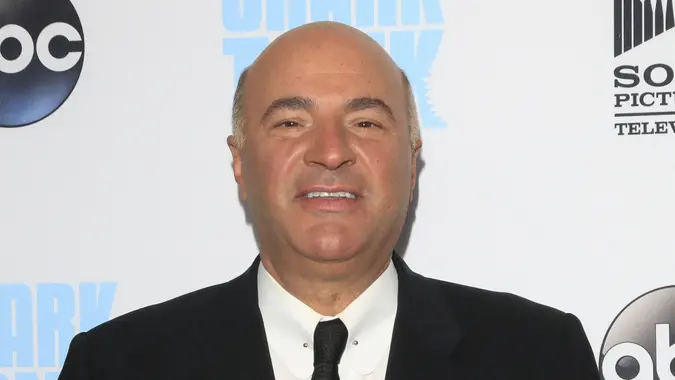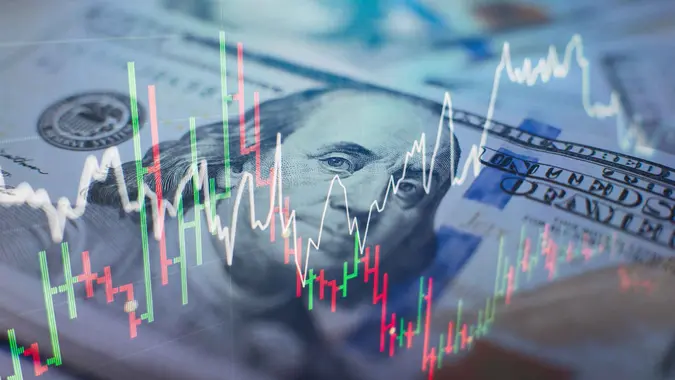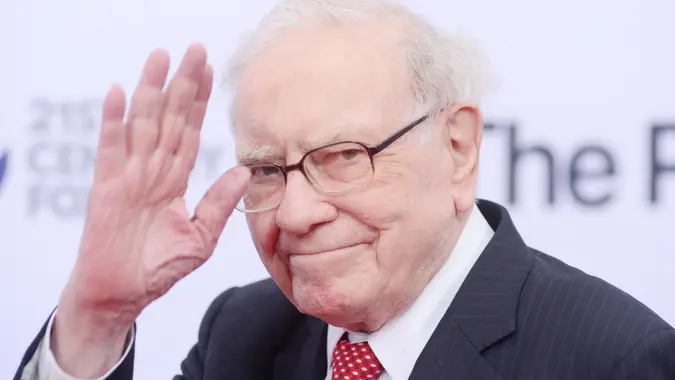Best Low-Cost Index Funds for October 2024

Commitment to Our Readers
GOBankingRates' editorial team is committed to bringing you unbiased reviews and information. We use data-driven methodologies to evaluate financial products and services - our reviews and ratings are not influenced by advertisers. You can read more about our editorial guidelines and our products and services review methodology.

20 Years
Helping You Live Richer

Reviewed
by Experts

Trusted by
Millions of Readers
Low-cost index funds provide instant portfolios that might otherwise take years or even decades, to build if you cobbled them together on a share-by-share basis. A single investment gives you indirect exposure to every company on whichever index your fund of choice tracks.
They’re among the most popular investments on the market because they’re simple, they mitigate risk and they usually outperform much more expensive actively managed funds.
The problem is that low-cost index funds are so popular that there are now thousands of them to choose from. This list will help you narrow down your options. Here’s a look at some of the best and most affordable index funds you can buy.
10 Best Low-Cost Index Funds
The following is a list of 10 index funds that trade as exchange-traded funds and offer wide market exposure and low expense ratios. If two funds had nearly identical holdings, the one with the lower expense ratio made the cut. When two had the same holdings and the same expense ratio, the fund with greater assets under management earned a place on the list.
| Low-Cost Index Fund | Expense Ratio |
|---|---|
| iShares Core S&P 500 ETF (IVV) | 0.03% |
| Invesco Nasdaq 100 ETF (QQQM) | 0.15% |
| Vanguard Mid-Cap ETF (VO) | 0.04% |
| Vanguard Small-Cap ETF (VB) | 0.05% |
| iShares Core S&P Total U.S. Stock Market ETF (ITOT) | 0.03% |
| Vanguard Total International Stock ETF (VXUS) | 0.08% |
| Vanguard FTSE Developed Markets ETF (VEA) | 0.06% |
| Vanguard Total World Stock ETF (VT) | 0.07% |
| iShares U.S. Treasury Bond ETF (GOVT) | 0.05% |
| iShares Core U.S. Aggregate Bond ETF (AGG) | 0.03% |
1. iShares Core S&P 500 ETF (IVV)
- Expense ratio: 0.03%
- Top five holdings: Apple, Microsoft, Nvidia, Amazon, Meta
- Pros: Low expense ratio; broad market exposure
- Cons: Tech heavy; high share price
Three of the four biggest ETFs in the world all track the same index, the S&P 500. The benchmark contains the 500 biggest U.S. corporations, which serve as a bellwether for the stock market as a whole — and one share of IVV gives you exposure to all of them.
2. Invesco Nasdaq 100 ETF (QQQM)
- Expense ratio: 0.15%
- Top five holdings: Apple, Microsoft, Nvidia, Broadcom, Meta Platforms Inc.
- Pros: Index includes 100 of largest U.S. and international nonfinancial companies; fund rebalanced quarterly
- Cons: Tech heavy
Invesco QQQ has long stood alone as the go-to growth fund for tracking the top nonfinancial companies on the Nasdaq-100 — but its relatively high 0.2% expense ratio was always a turnoff. QQQM solved that problem by delivering nearly identical holdings and performance for five fewer basis points.
3. Vanguard Mid-Cap ETF (VO)
- Expense ratio: 0.04%
- Top five holdings: Amphenol, Motorola Solutions, Inc., TransDigm, Welltower Inc., Cintas Corp.
- Pros: Diverse sectors well represented; strong performance over long term
- Cons: Aggressive fund vulnerable to significant fluctuations; might be less liquid than large-cap funds
The S&P 500 and Nasdaq-100, which the previous two funds track, are both large-cap indexes. VO gives you exposure to over 300 medium-sized companies on the CRSP US Mid Cap Index. Investors bet on these companies because they’re big enough to have gained traction but still have plenty of room to grow.
4. Vanguard Small-Cap ETF (VB)
- Expense ratio: 0.05%
- Top five holdings: Targa Resources, Axon Enterprise Inc., Smurfit WestRock plc, Deckers Outdoor, First Citizens BancShares Inc.
- Pros: Potential for high growth; about 1,400 holdings add diversity within small-cap category
- Cons: Riskier than large- and medium-cap funds; could be less liquid than large- and medium-cap funds
The smallest publicly traded stocks offer growth potential that the corporate giants on the S&P 500 and even the mid-caps can’t match — but the trade-off is greater volatility and higher risk. A single share of VB adds exposure to roughly 1,400 small-caps to your portfolio.
5. iShares Core S&P Total US Stock Market ETF (ITOT)
- Expense ratio: 0.03%
- Top five holdings: Apple, Microsoft, Nvidia, Amazon, Meta
- Pros: Broader exposure than S&P 500 index fund; low expense ratio
- Cons: Tech heavy
Investors looking for a piece of the entire U.S. stock market could buy IVV, VO and VB to gain exposure to the top large-cap, mid-cap and small-cap indexes. But the quicker and simpler route would be an investment in ITOT, which offers convenient, one-and-done access to the entire U.S. stock market through over 2,500 holdings in a single fund.
6. Vanguard Total International Stock ETF (VXUS)
- Expense ratio: 0.08%
- Top five holdings: Taiwan Semiconductor Manufacturing Co., Novo Nordisk, ASML Holding, Tencent Holdings, Nestle SA
- Pros: Broad exposure to international stocks; weighted toward large-cap stocks
- Cons: Risky, with over 25% of portfolio invested in emerging markets
The first half of the list covers some of the cheapest index funds for U.S.-based companies. Those looking to add exposure to international stocks should consider VXUS, which mirrors the performance of the FTSE Global All Cap ex US Index. It offers exposure to over 8,500 stocks in both developed and emerging countries.
7. Vanguard FTSE Developed Markets ETF (VEA)
- Expense ratio: 0.06%
- Top five holdings: Novo Nordisk, ASML Holding, Nestle, Samsung, AstraZeneca
- Pros: International stock exposure; invests mostly in large-cap stocks, which have lower risk
- Cons: Possibly less growth potential than with emerging markets; low returns compared to other index ETFs
International investors who want to isolate only companies based in more stable and familiar developed nations might buy VEA. The fund tracks the performance of a diverse blend of large-, mid- and small-cap companies based mostly in Canada, Europe and the Pacific region.
8. Vanguard Total World Stock ETF (VT)
- Expense ratio: 0.07%
- Top five holdings: Apple, Microsoft, Nvidia, Amazon, Facebook (Meta)
- Pros: High growth potential; risk balanced by weighting toward North American stocks
- Cons: Risky, moderately aggressive fund; recommended for investors able to hold for a decade or longer
For the ultimate in global equity diversification, consider VT, which tracks the FTSE Global All Cap Index. The fund includes nearly 10,000 companies from both the U.S. and overseas, including both well-established and still-developing markets.
9. iShares US Treasury Bond ETF (GOVT)
- Expense ratio: 0.05%
- Top holdings: U.S. Treasury securities (99.86% of holdings) and cash (0.14%)
- Pros: Affordable shares with negligible risk; covers broad U.S. Treasurys market
- Cons: Low returns; vulnerable to interest rate risk
For more complete diversification, investors can balance their stock holdings with lower-risk fixed-income securities like bonds. GOVT offers over 100 U.S. Treasurys with maturities ranging from one year to 30 years.
10. iShares Core US Aggregate Bond ETF (AGG)
- Expense ratio: 0.03%
- Top five holdings: U.S. Treasurys, Federal National Mortgage Association, Government National Mortgage Association, Federal Home Loan Mortgage Corp., Uniform MBS
- Pros: Lower-risk investment-grade bond fund; low fees
- Cons: Low returns; weighted toward mortgage-related securities
When bond investors refer to the “agg,” they’re talking about the Bloomberg US Aggregate Bond Index. AGG tracks that index and offers broad exposure to U.S. investment-grade bonds.
What Is a Low-Cost Index Fund?
Because they’re passively managed, index funds have much lower fees than traditional actively managed mutual funds. But ETFs can match or beat the tiny expense ratios associated with index funds without the minimum investment requirements. Index ETFs are passively managed and mirror broad indexes, just like index funds, but they have the added benefit of trading in shares on the open market. That makes them nearly identical in composition and function, yet more accessible and easier to trade through any brokerage.
How Much Does It Cost To Have an Index Fund?
Traditional index funds are a type of mutual fund, and they typically have minimum buy-in requirements. Index funds from BlackRock, the largest investment firm in the world in terms of assets under management, require a minimum investment of $1,000. Vanguard, the largest issuer of mutual funds, requires a $3,000 minimum investment on most of its mutual funds.
Can You Lose Money With Index Funds?
You can lose money with any investment, and index funds are no exception. Millions of portfolios contain index funds because their diverse holdings offer a hedge against risk, but those diverse holdings include stocks and other securities with potentially turbulent pricing.
Can I Buy Index Funds With $100?
If you choose index ETFs, you can start investing with $100 or even $1 as long as you choose a no-fee brokerage that allows for fractional-share investing. M1 Finance, Fidelity Investments and Interactive Brokers are among the most popular.
With fractional-share investing, it doesn’t matter how much the ETF trades for — you simply invest as much as you have, and you’ll own whatever percentage of a share that your money can buy.
The most important number for any ETF is its expense ratio — that’s what it costs to own an ETF, and lower is better. Expense ratios are expressed as percentages of your investment, so a 0.30% expense ratio would cost you $30 per year for every $10,000 you invest.
When searching for low-cost index ETFs, ignore the share price and focus on the expense ratio.
Shop Around Before Investing In Low-Cost Index Funds
The index funds you just read about have many close competitors, each of which offers different holdings, blends, objectives, characteristics, historical performance and expense ratios. Before you invest in an index fund, read the fund’s prospectus, which contains all the important facts associated with that fund, to make sure you’re buying one that matches your investment goals and strategy.
FAQ
Here's more information about index funds to help you decide if they're right for you.- What are the lowest-cost index funds?
- The iShares Core S&P 500 ETF and iShares Core U.S. Aggregate Bond ETF are among the lowest in terms of expense ratio: 0.03%. The iShares U.S. Treasury Bond ETF has one of the lowest share prices — $23.39 as of Oct. 2.
- Which S&P 500 index fund has the lowest fees?
- The SPDR Portfolio S&P 500 ETF has the lowest fees at 0.02%, according to the ETF.com database.
- What is the best index fund for beginners?
- Which fund is best depends on the investor. If you're looking for an ultraconservative index fund with almost no risk, consider the iShares U.S. Treasury Bond ETF. If you prefer a stock fund, the iShares Core S&P Total U.S. Stock Market ETF is a good choice because it represents the entire stock market.
- Is it good to invest in a low-cost index fund?
- It can be. All funds have risk. If you're comfortable with that, a low-cost fund can be a relatively safe way to add instant diversification to your portfolio.
Daria Uhlig and Cynthia Measom contributed to the reporting for this article.
Data is accurate as of Oct. 3, unless otherwise noted, and is subject to change.
Editorial Note: This content is not provided by any entity covered in this article. Any opinions, analyses, reviews, ratings or recommendations expressed in this article are those of the author alone and have not been reviewed, approved or otherwise endorsed by any entity named in this article.
 Written by
Written by  Edited by
Edited by 




























